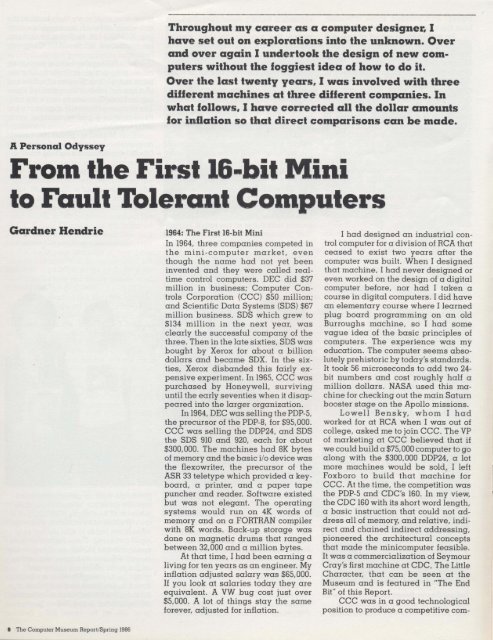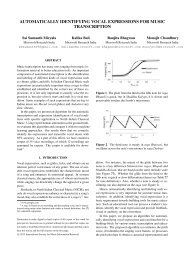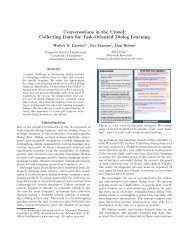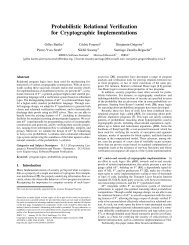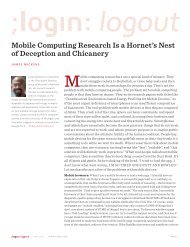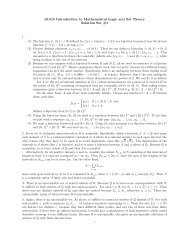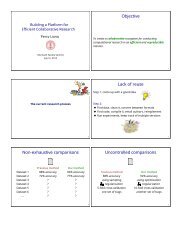TCM Report, Spring - Microsoft Research
TCM Report, Spring - Microsoft Research
TCM Report, Spring - Microsoft Research
You also want an ePaper? Increase the reach of your titles
YUMPU automatically turns print PDFs into web optimized ePapers that Google loves.
A Personal Odyssey<br />
Throughout my career as a computer designer. I<br />
have set out on explorations into the unknown. Over<br />
and over again I undertook the design of new computers<br />
without the foggiest idea of how to do it.<br />
Over the last twenty years. I was involved with three<br />
different machines at three different companies. In<br />
what follows. I have corrected all the dollar amounts<br />
for inflation so that direct comparisons can be made.<br />
From the First 16·bit Mini<br />
to Fault Tolerant Computers<br />
Gardner Hendrie<br />
• The Computer Museum <strong>Report</strong>/<strong>Spring</strong> 1986<br />
1964: The First 16-bit Mini<br />
In 1964, three companies competed in<br />
the mini-computer market, even<br />
though the name had not yet been<br />
invented and they were called realtime<br />
control computers. DEC did $37<br />
million in business; Computer Controls<br />
Corporation (CCC) $50 million;<br />
and Scientific Data Systems (SDS) $67<br />
million business. SDS which grew to<br />
$134 million in the next year, was<br />
clearly the successful company of the<br />
three. Then in the late sixties, SDS was<br />
bought by Xerox for about a billion<br />
dollars and became SDX. In the sixties,<br />
Xerox disbanded this fairly expensive<br />
experiment. In 1965, CCC was<br />
purchased by HoneywelL surviving<br />
until the early seventies when it disappeared<br />
into the larger organization.<br />
In 1964, DEC was selling the PDP-5,<br />
the precursor of the PDP-8, for $95,000.<br />
CCC was selling the DDP24, and SDS<br />
the SDS 910 and 920, each for about<br />
$300,000. The machines had 8K bytes<br />
of memory and the basic i/o device was<br />
the flexowriter, the precursor of the<br />
ASR 33 teletype which provided a keyboard,<br />
a printer, and a paper tape<br />
puncher and reader. Software existed<br />
but was not elegant. The operating<br />
systems would run on 4K words of<br />
memory and on a FORTRAN compiler<br />
with 8K words. Back-up storage was<br />
done on magnetic drums that ranged<br />
between 32,000 and a million bytes.<br />
At that time, I had been earning a<br />
living for ten years as an engineer. My<br />
inflation adjusted salary was $65,000.<br />
If you look at salaries today they are<br />
equivalent. A VW bug cost just over<br />
$5,000. A lot of things stay the same<br />
forever, adjusted for inflation.<br />
I had designed an industrial control<br />
computer for a division of RCA that<br />
ceased to exist two years after the<br />
computer was built. When I designed<br />
that machine, I had never designed or<br />
even worked on the design of a digital<br />
computer before, nor had I taken a<br />
course in digital computers. I did have<br />
an elementary course where I learned<br />
plug board programming on an old<br />
Burroughs machine, so I had some<br />
vague idea of the basic principles of<br />
computers. The experience was my<br />
education. The computer seems absolutely<br />
prehistoric by today's standards.<br />
It took 56 microseconds to add two 24bit<br />
numbers and cost roughly half a<br />
million dollars. NASA used this machine<br />
for checking out the main Saturn<br />
booster stage on the Apollo missions.<br />
Lowell Bensky, whom I had<br />
worked for at RCA when I was out of<br />
college, asked me to join CCC. The VP<br />
of marketing at CCC believed that if<br />
we could build a $75,000 computer to go<br />
along with the $300,000 DDP24, a lot<br />
more machines would be sold. I left<br />
Foxboro to build that machine for<br />
CCC. At the time, the competition was<br />
the PDP-5 and CDC's 160. In my view,<br />
the CDC 160 with its short word length,<br />
a basic instruction that could not address<br />
all of memory, and relative, indirect<br />
and chained indirect addressing,<br />
pioneered the architectural concepts<br />
that made the minicomputer feasible.<br />
It was a commercialization of Seymour<br />
Cray's first machine at CDC, The Little<br />
Character, that can be seen at the<br />
Museum and is featured in "The End<br />
Bit" of this <strong>Report</strong>.<br />
CCC was in a good technological<br />
position to produce a competitive com-


